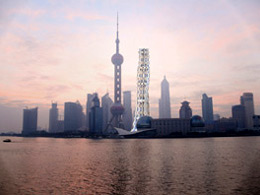STUDENTS PROJECTS
PROJECTS2013

03 September, 2013
Vortex tower
The Urban Hub.The present Diploma Thesis investigates the use of digital tools in dealing with the new issues of the high rise typology. Recognizing the tall building as the most proper response to urbanization and the need for higher density in cities, decrease in their environmental footprint and improvement in the quality of life the proposal attempts to elevate the urban life experience, introducing adaptability and environmental response.
Student : Vangel Kukov
Supervisor: Maria Voyatzaki
Aristotle University of Thessaloniki
Date : 21/02/2013

Design Process.
The present Diploma Thesis investigates the use of digital tools in dealing with the new issues of the high rise typology. Recognizing the tall building as the most proper response to urbanization and the need for higher density in cities, decrease in their environmental footprint and improvement in the quality of life the proposal attempts to elevate the urban life experience, introducing adaptability and environmental response.
Considering all the above the design criteria are set:
Public ground level, free access entrance level- connections with the urban fabric.
Sky Lobbies- elevated public, green spaces.
Use of smart geometry, local materials-prefabrication, clean energy production.
The chosen location for the tower is the economic and cultural centre of Shanghai- Pudong. Design aim is both the extension of the Century park, adjacent to the site, via the public ground level and also the integration of the tower with the cluster of super high building of the city .
The geometry chosen to give shape to the design intentions is that of the Triply Periodic Minimal Surfaces. Their architectural and spatial qualities as well as their integrated 'intelligence' make them applicable in high complexity architectural structures. The Digital construction of such surfaces in examined with methods derived from both mathematics and physics- parametric equations, mesh relaxation, Laplacian smoothing and their morphing into a 3d grid. The use of tools for spatial and functional analysis- Shortest path, Isovist, inform and enrich the grid. Building complexity, alternative lay outs and their connectivities are examined. The relations between interior and exterior space they produce, the diversity and experience of space they provide. The continuum of the structure is translated into continuum of space, blurring the borders between private and public.
For the feasible materialization of the system the use of computer numerical control (CNC) machines is utilized in the reinvention of an ancient building material- the clay in combination with a post-tensioning technique for the structural completion of the structure. The multifunctionality of the building system is underlined and structural (FEA) analysis and aerodynamic (CFD) analysis are performed.

Site Plan.

Elevations.
Entrance/Sky Lobby level plan.
Sections.

Perspectives.

Interiors.

Interiors.

Interiors.










